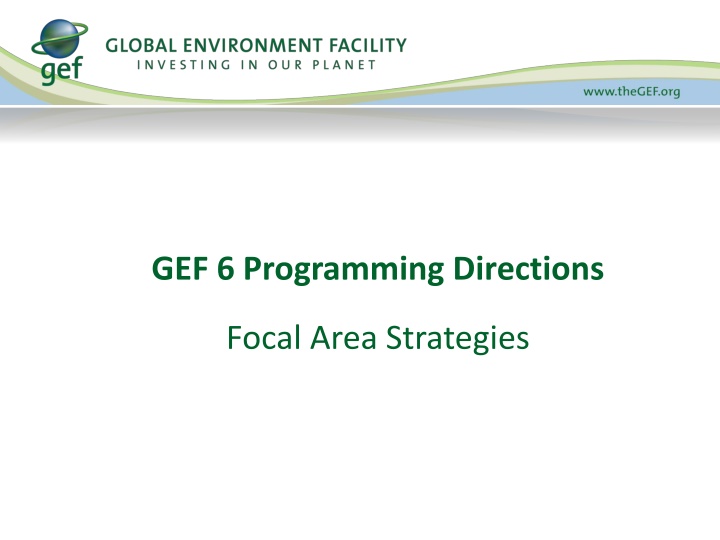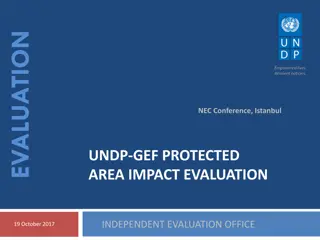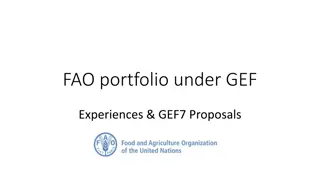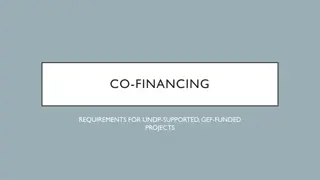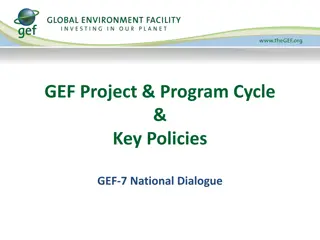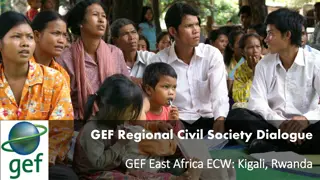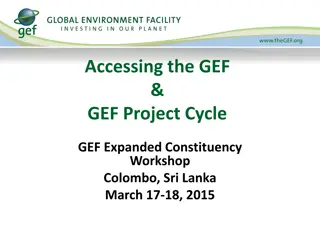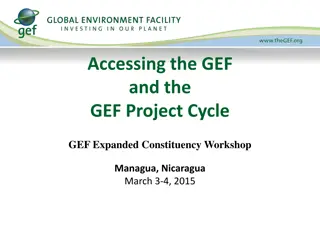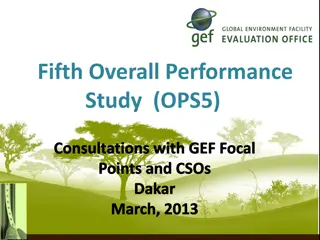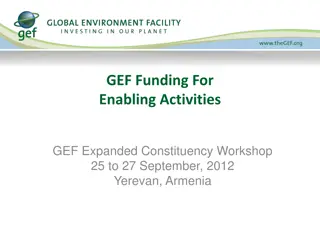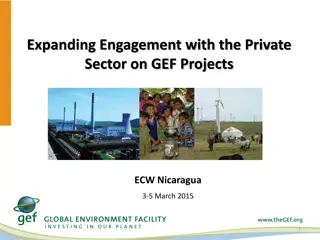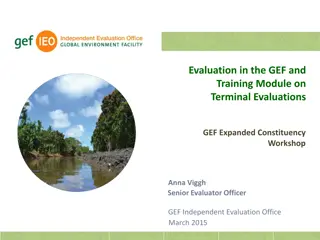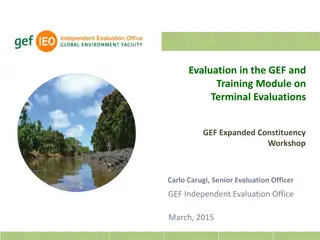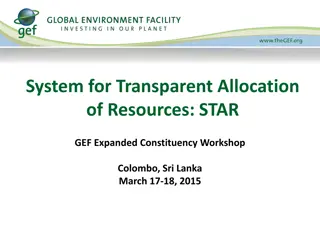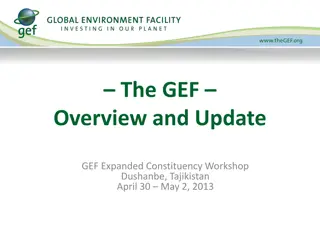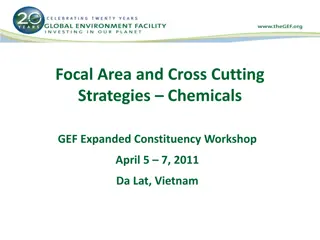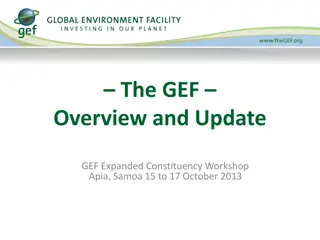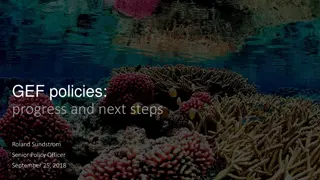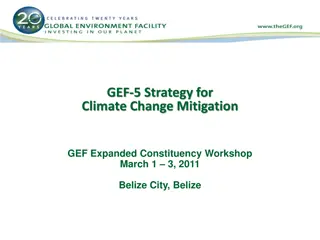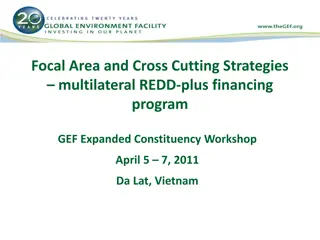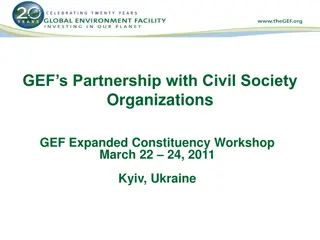GEF 6 Programming Directions
Addressing biodiversity loss, the Aichi Strategic Goals and Targets aim to integrate biodiversity values, reduce direct pressures on ecosystems, improve conservation efforts, and enhance benefits for all stakeholders.
Download Presentation

Please find below an Image/Link to download the presentation.
The content on the website is provided AS IS for your information and personal use only. It may not be sold, licensed, or shared on other websites without obtaining consent from the author.If you encounter any issues during the download, it is possible that the publisher has removed the file from their server.
You are allowed to download the files provided on this website for personal or commercial use, subject to the condition that they are used lawfully. All files are the property of their respective owners.
The content on the website is provided AS IS for your information and personal use only. It may not be sold, licensed, or shared on other websites without obtaining consent from the author.
E N D
Presentation Transcript
GEF 6 Programming Directions Focal Area Strategies
Refreshed Focal Area Strategies and Integrated Approaches SD Themes Food Security Sustainable Cities Forests Fisheries Integrated Approaches Commodities Sub-Saharan Africa FS Cities Sustainable Forest Biodiversity Climate Change International Management Degradation Chemicals Focal Area Strategy Delivery Waters Land
Biodiversity Focal Area Supports implementation of CBD - Delivering on the Aichi Strategic Goals and Targets
5 Goals and 20 Aichi Biodiversity Targets Strategic goal A. Address the underlying causes of biodiversity loss Target 1: By 2020, People are aware of the values of biodiversity and the steps they can take to conserve and use it sustainably. Target 2: By 2020, biodiversity values are integrated into national and local development and poverty reduction strategies and planning processes and national accounts. Target 3: By 2020, incentives, including subsidies, harmful to biodiversity are eliminated, phased out or reformed. Target 4: By 2020, Governments, business and stakeholders have plans for sustainable production and consumption and keep the impacts resource use within safe ecological limits. Strategic goal B. Reduce the direct pressures on biodiversity and promote sustainable use Target 5: By 2020, the rate of loss of all natural habitats, including forests, is at least halved and where feasible brought close to zero, and degradation and fragmentation is significantly reduced. Target 6: By 2020 all stocks managed and harvested sustainably, so that overfishing is avoided. Target 7: By 2020 areas under agriculture, aquaculture and forestry are managed sustainably, ensuring conservation of biodiversity. Target 8: By 2020, pollution, including from excess nutrients, has been brought to levels that are not detrimental to ecosystem function and biodiversity. Target 9: By 2020, invasive alien species and pathways are identified and prioritized, priority species are controlled or eradicated, and measures are in place to manage pathways to prevent their introduction and establishment. Target 10: By 2015, the multiple anthropogenic pressures on coral reefs, and other vulnerable ecosystems impacted by climate change or ocean acidification are minimized, so as to maintain their integrity and functioning. Strategic goal C: To improve the status of biodiversity by safeguarding ecosystems, species and genetic diversity Target 11: By 2020, at least 17 per cent of terrestrial and inland water, and 10 per cent of coastal and marine areas are conserved through systems of protected areas. Target 12: By 2020 the extinction of known threatened species has been prevented and their conservation status, particularly of those most in decline, has been improved and sustained. Target 13: By 2020, the genetic diversity of cultivated plants and farmed and domesticated animals and of wild relatives is maintained. Strategic goal D: Enhance the benefits to all from biodiversity and ecosystem services Target 14: By 2020, ecosystems that provide essential services, including services are restored and safeguarded. Target 15: By 2020, ecosystem resilience and the contribution of biodiversity to carbon stocks has been enhanced, through conservation and restoration, including restoration of at least 15 per cent of degraded ecosystems. Target 16: By 2015, the Nagoya Protocol on Access and Benefits Sharing is in force and operational. Strategic goal E. Enhance implementation through participatory planning, knowledge management and capacity building Target 17: By 2015 each Party has developed, adopted as a policy instrument, and has commenced implementing an effective, participatory and updated NBSAP. Target 18: By 2020, the traditional knowledge, innovations and practices of indigenous and local communities and their customary use, are respected. Target 19: By 2020, knowledge, the science base and technologies relating to biodiversity, its values, functioning, status and trends, and the consequences of its loss, are improved, widely shared and transferred, and applied. Target 20: By 2020, the mobilization of financial resources for effectively implementing the Strategic Plan for Biodiversity 2011-2020 from all sources,, should increase substantially.
Biodiversity mainstreaming Protection ABS Protected areas Understand values Sustainable fisheries Implement Nagoya Prot. Prevent extinctions Mainstream biodiversity Manage within limits Enabling Conserve gene pool Revise NBSAPs Address incentives Reduce pollution Respect and conserve TK Restoration Sustainable production Reduce invasive spp. Restore ecosystems Improve knowledge Minimize reef loss Enhance resilience Halve rate of loss Mobilize resources
GEF-6 BD Objectives and Programs Goal: To maintain globally significant biodiversity and the ecosystem goods and services that it provides to society BD 2: Reduce threats to Globally Significant Biodiversity BD1: Improve Sustainability of Protected Area System BD4: Mainstreaming Biodiversity Conservation and Sustainable Use in Production Landscapes/ Seascapes and Sectors BD 3: Sustainable Use of Biodiversity 6. Ridge to Reef: Maintaining integrity and function of globally significant coral reefs 3. Preventing extinction of known threatened species 9. Managing the Human- interface: landscape/seascape approach 1. Improving financial sustainability and effective management of national ecological infrastructure 7. Securing Agriculture s Future: Sustainable use of plants and animals genetic resources. 4. Prevention, control, and mgmt of Invasive Alien Species. 10. Integration of biodiversity and ecosystem services in development and financial planning 2 . Expanding the reach of the global protected area estate. 8. Implementing the Nagoya Protocol on Access and Benefit Sharing. 5. Implementing the Cartagena Protocol of Biosafety
Land Degradation Focal Area Sustainable Land Management .a knowledge-based procedure that integrates land, water, biodiversity, and environmental management to meet rising food and fiber demands while sustaining livelihoods and the environment (World Bank 2006).
GEF-6 LD Objectives and Programs Goal: To arrest or reverse land degradation (desertification and deforestation) LD 1: Agriculture and Rangeland Systems LD 2: Forest Landscapes LD 3: Integrated Landscapes LD 4: Institutional and Policy Frameworks 3. Landscape Management and Restoration community and livelihood-based options for increasing forest and tree cover 1. Agro-ecological Intensification efficient use of natural capital (land, soil, water, and vegetation) in crop and livestock production systems 5. Mainstreaming SLM in Development influencing institutions, policies, and governance frameworks for SLM 4. Scaling-up SLM moving appropriate interventions to scale for crop and rangeland productivity 2. SLM in Climate-Smart Agriculture innovative practices for increasing vegetative cover and soil organic carbon
Sustainable Forest Management Managing Forests for Multiple Benefits
Sustainable Forest Management GEF-6 Strategy Goal: To achieve multiple environmental, social and economic benefits from improved management of all types of forests and trees outside of forests. SFM 2: To enhance forest management SFM 3: To restore forest ecosystems SFM 4: To increase regional and global cooperation SFM 1: To maintain forest resources Integrated land use planning Identification and monitoring of HCVF Identifying and monitoring forest loss Developing and implementing model projects for PES Capacity development for SFM within local communities Supporting sustainable finance mechanisms for SFM Building of technical and institutional capacities to identify degraded forest landscapes and monitor forest restoration Integrating plantation management in landscape restoration Private sector engagement Global technologies for national progress
International Waters Focal Area Goal: to promote collective management for transboundary water systems and foster policy, legal, and institutional reforms and investments towards sustainable use and maintenance of ecosystem services. Focus: joint management of shared water systems to balance competing uses and enabling sharing of benefits from their utilization. Where does the GEF work river basins, lakes, aquifers, LMEs & open oceans
GEF-6 IW Strategy Goal: To promote collective management of transboundary water systems and implementation of the full range of policy, legal and institutional reforms and investments contributing to sustainable use and maintenance of ecosystem services Objective 2: Balancing Competing Water-uses in the Management of Transboundary Surface and Groundwater Objective 3: Rebuilding Marine Fisheries, Restore and Protect Coastal Habitats, and Reduce Pollution of Coasts and LMEs Objective 1: Catalyze Sustainable Management of Transboundary Waters 1 Foster Cooperation for Sustainable Use of Trans- boundary Water Systems & Economic Growth 3 Advance Conjunctive Management of Surface & Groundwater Systems 5 Reduce Ocean Hypoxia 6 Prevent the Loss and Degradation of Coastal Habitat 2 Increase Resilience & Flow of Ecosystems Services in Context of Melting High Altitude Glaciers 4 Water/Food/Energy/ Ecosystem Security Nexus 7 Foster Sustainable Fisheries
GEF IW investments through series of interventions Delivering GEF International Waters Global Environment Benefits Full-scale SAP Implementation Strengthening policy and legal and institutional frameworks Foundational Capacity Building/Enabling environments, Basic Policy and cooperation framework
GEF-6 CCM Strategy Goal: To support developing countries to make transformational shifts towards low emission, resilient development path Objective 3: Foster enabling conditions to mainstream mitigation concerns into SD strategies Objective 1: Promote innovation & technology transfer Objective 2: Demonstrate systemic impacts of mitigation options 5. Convention obligations for planning and mitigation contributions 1. Low carbon technologies and mitigation options 3. Integrated low-carbon, urban systems 2 . Innovative policy packages and market initiatives 4. Forests and other land use, and climate smart agriculture
GEFs Unique Value for Climate Financing 1. Facilitating innovation & technology transfer Assisting developing countries in defining and implementing mitigation measures towards 2015 agreement 2. Catalyzing systemic impacts through synergistic multi-focal initiatives 3. Building on Convention obligations for reporting & assessments towards mainstreaming
GEF-6: Adaptation Programming Strategy Least Developed Countries Fund (LDCF) and Special Climate Change Fund (SCCF) Thematic Priorities for Adaptation Agriculture and food security Water resources management Coastal zone management Infrastructure Disaster risk management Natural resources management Health Climate information services Climate-resilient urban systems Small Island Developing States
Adaptation Programming Strategy 1) Reduce the vulnerability of people, livelihoods, physical assets and natural systems Aims to increase resilience to the adverse impacts of climate change in vulnerable developing countries, through both near- and long- term adaptation measures in affected sectors, areas and communities (GEF/LDCF.SCCF.16/03) 2) Strengthen institutional and technical capacities 3) Integrate climate change adaptation into relevant policies, plans and associated processes
Chemicals and Waste Focal Area Goal: to prevent the exposure of human and the environment to harmful C&W of global importance, including POPs, mercury and ODS, through a significant reduction in the production, use, consumption and emissions/releases of those chemicals and waste Objective 1: Develop the enabling conditions, tools and environment for the sound management of harmful chemicals and wastes Objective 2: Reduce the prevalence of harmful chemicals and waste and support the implementation of clean alternative technologies/substances 3. Reduction and elimination of POPs 1. Develop and demonstrate new tools and economic approaches for managing harmful chemicals and waste in a sound manner 4. Reduction or elimination of anthropogenic emissions and releases of mercury to the environment 5. Complete the phase out of ODS in CEITs and assist Article 5 countries under the Montreal Protocol to achieve climate mitigation benefits 2. Support enabling activities and promote their integration into national budgets and planning processes, national and sector policies and actions and global monitoring 6. Support regional approaches to eliminate and reduce harmful chemicals and waste in LDCs and SIDs
C & W Innovative Approaches Piloting of cleaner production to remove toxics including new POPS and mercury from products through partnerships with the private sector. Removing the barriers for investment of the private sector to manage waste streams. Promoting access to finance to small and medium enterprises to allow for investment particularly in waste recycling, ASGM and other sectors that can generate income but are difficult to invest in due to risk or nature of the sector.
